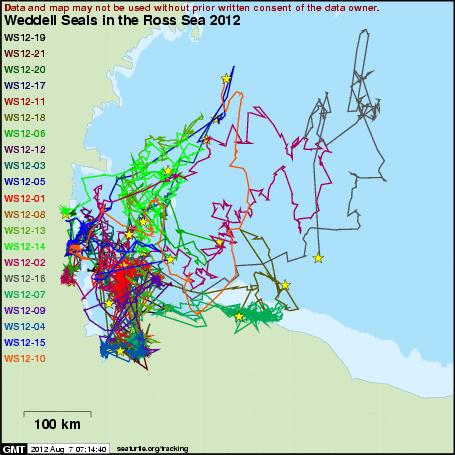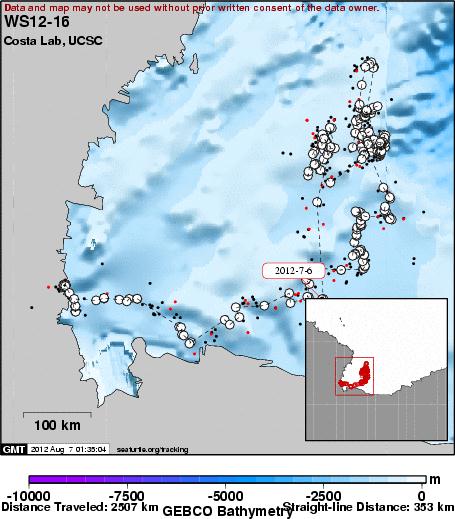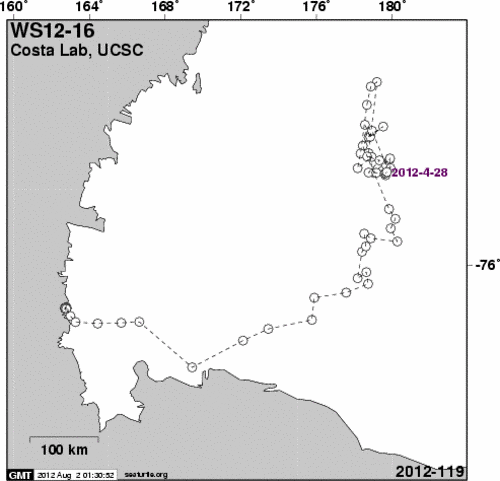Oh where, oh where are those little – I mean big - seals?
Have you asked yourself that question? I know I have… And my curiosity has gotten the better of me.
So what am I doing about it, you ask?
That’s a great question and to find the answer I’ve checked out the following website – http://seaturtle.org/
I know, I know – you are probably asking yourself why I’m looking at a Sea Turtle website when our team tagged Weddell seals. A logical question I might add! But the nice folks at Seaturtle.org let our team use their website so – YOU – could follow our seals too! Wasn’t that nice!
By clicking that link, it should take you to the main page. Once you’ve gotten to the site, type ‘Weddell Seals in the Ross Sea 2012’ into the search engine.
If that doesn’t work, you can also click here http://www.seaturtle.org/tracking/?project_id=707

What will this website tell us?
This website tells us quite a lot about each seal. Let’s start with the table you see here.
It lists several categories:
- Name
- Species
- Life Stage
- Release Date
- Last Location
- Days Transmitted
Let’s take a closer look at each category.
Name
This lists the technical name of each seal we tagged, for example - WS12-19.
The first two letters (WS) stand for Weddell seal.
The next two numbers (12) stand for the year our team tagged the seals – 2012.
Notice the WS12 is the same for all of the seals.
The last two numbers indicate each particular seal. Our team tagged a total of 21 seals, so seal 19 was tagged in the example above.
Species
Weddell seals were the only species of seal our team tagged.
Life Stage
All of our seals were adults.
Release Date
This tells you the actual date our satellite tags were released or put on the seals.
Last Location
This date tells the scientists – and us – the last day that particular satellite tags transmitted any data. You will notice that not all of the seals are transmitting data - and there are a number of reasons why the tags fail:
- Dead battery
- Antenna may be broken
- Tag may have fallen off
- Saltwater switch may have failed
- Or the seal may have died
For more information about the satellite tags click here (http://www.polartrec.com/expeditions/weddell-seals-in-the-ross-sea/journals/2012-01-26)
Days Transmitted
This number tells us how many days the tag has been transmitting data to the satellite.
Also in the table you will notice that some of the information in each row appears black and some grey. The seals that have recently transmitted information are in black while those that have not transmitted information recently are grey.
Travel Map
At the bottom of the Weddell seal main webpage is a map showing the travel patterns for each seal - although it looks a little like a three year old has tried to create an artistic master piece.

Seal 16’s line (the grey line) caught my eye! He has taken quite a journey during the Antarctic winter. The scientists are finding that these seals are traveling much further than they originally hypothesized.
A Closer Look at seal 16
You can also look at each individual seal’s journey by clicking on their number. For example, by clicking WS12-16 in the table you can see just how far he has travelled. Oh, by the way, the team nick-named many of the seals – this one was named ‘Sonic’.


So, as long as the seal’s antenna is still sending information to the satellite you can see exactly where each seal has been since they were tagged. Unfortunately, some of the antennas on the seals have stopped transmitting information, but we are still getting lots of information from the other seals with working antennas.
What happens next?
During the October/November field season (2012) some of the members of my team will return to Antarctica to look for the seals we tagged back in January and February. They hope to find the seals (although it will be difficult), retrieve the tags, then collect and analyze the data. The team has found that by retrieving the tags they are able to get nearly 4 times the amount of data – that’s quite a difference! Unfortunately, I will not be able to go this time – but we wish them luck!
LOOK FOR OUR NEXT JOURNALS – AS I WILL INTRODUCE ALL 21 SEALS TO YOU!


Comments